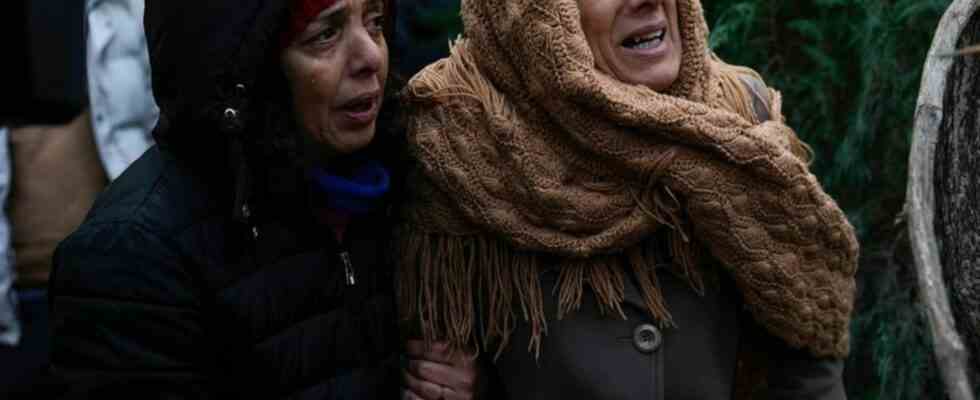The border region between Syria and Turkey is war-torn, plagued by economic hardship and home to millions of refugees. Severe earthquakes increase the suffering immeasurably.
Night is still over southern Turkey and northern Syria as the earth trembles. Suddenly, walls shake, asphalt rips open, houses collapse. The tremors of the earthquakes in Israel, Lebanon, Cyprus and Iraq can be felt. While it was still dark, rescuers in both countries were trying to pull people out of the rubble. On the day of the disaster, authorities and aid organizations on both sides of the Turkish-Syrian border counted around 2,300 dead and around 11,000 injured, and the trend is rising.
At dawn, as rain, snow and cold winds sweep across the region, the extent of the destruction becomes apparent. Geological institutes record an earthquake magnitude of 7.7. According to the Turkish civil protection authority Afad, the epicenter was in the province of Kahramanmaras near the Syrian border – with dozens of aftershocks. Another 7.5 magnitude tremor shook southeastern Turkey later today. In Turkey alone, authorities count more than 1,100 dead, and the trend is rising.
Ten different provinces are affected in south-eastern Turkey. From these regions come reports of dead, buried, but also rescued. The NTV broadcaster shows how a girl is rescued from the rubble and taken away wrapped in blankets.
Collapsed like a house of cards
According to official information, the rescuers rescued more than 2,000 survivors from the rubble. A six-story building collapsed like a house of cards in Sanliurfa province, videos show. Authorities are warning people not to go back to their homes. It’s bitterly cold outside, and it’s snowing heavily in Malatya province.
An eyewitness in Hatay tells the dpa that she has been in the car since the earthquake. “It’s cold and we don’t know how to get through it.” Half of the city feels like it’s in ruins, the hospital is full of injured people, including children. In the early afternoon, no helpers were on site.
Panic scenes also take place at night at Gaziantep Airport. A video shows travelers with bags running out of a hall to the exit to the sound of sirens, with older people tripping behind. The airport in southern Turkey’s Hatay is partially destroyed: the asphalt of the runway has been pushed together by the pressure of the quake and has burst, as pictures show. Planes will no longer take off or land here for the time being.
According to initial estimates, at least 2,000 buildings have collapsed in Turkey, including a hospital in Iskenderun. The walls of a historic castle in Gaziantep, built by the Romans in the 2nd century AD, have collapsed into a gray heap of rubble like a sandcastle on a beach.
Worse than it has been in decades
Haluk Özener, an expert at the Kandilli earthquake station in Istanbul, speaks of the strongest earthquake in Turkey for decades. In 1999, an earthquake near the Turkish metropolis of Istanbul killed more than 17,000 people.
Two of the largest continental plates meet on the territory of Turkey: the African and the Eurasian. In fact, for the majority of the Turkish population there is constant danger.
Amna, who lives with her family across the border near Aleppo in Syria, was hospitalized with multiple broken bones. “Our house collapsed over our heads. We had nowhere to go,” she reported to dpa in a weak voice on the phone. “My husband and some of my children are still under the rubble. God help me.”
There is also a video from Aleppo in which several houses apparently collapse in an aftershock. Children and adults run away screaming as dust rises above the rainy street behind them.
After almost twelve years of civil war, Syria has been destroyed in many places and the population has been worn down. Health care is poor in government-controlled areas. In the areas controlled by rebels, aid organizations such as SAMS are trying to ensure basic medical care. However, it is impossible for them to cope with the consequences of this catastrophe. There is a lack of beds, medicine and staff. Many doctors and specialists have fled after years of war.
Hundreds of families could still be buried
Rami Abdel-Rahman, whose Syrian Observatory for Human Rights has been following the conflict with the help of activists since 2011, speaks of hundreds of families still buried in northern Syria. “The rescuers are very few to meet the demands of this catastrophe,” he told dpa. The head of the National Earthquake Center says it is the strongest earthquake in Syria since 1995. In some cases, entire rows of houses have collapsed, the foundations of which had been damaged after a decade of war and air raids.
All relevant units in Turkey are on alert, writes Turkish President Erdogan on Twitter. In Syria, President Bashar al-Assad is calling his cabinet for an emergency meeting to coordinate aid. The situation is made even more difficult by the fact that humanitarian aid for the people in the rebel areas in the north-west only comes through the last border crossing, Bab al-Hawa, namely from Turkey. Because the Turkish side of this bottleneck is now itself affected by the disaster. Meanwhile, the EU Center for Disaster Relief is announcing support, and offers of help are also coming from Israel, Egypt and Saudi Arabia.
The catastrophe hits the Syrian refugees, some of whom live in makeshift accommodation such as abandoned houses in southern Turkey, particularly hard. “I thought the whole city would collapse,” reports Rami Araban from the aid organization CARE Germany in Gaziantep, where around half a million Syrian refugees live. “There’s no water and we’re standing outside in the snow when it’s below zero. People are crying. Everyone’s scared.”

